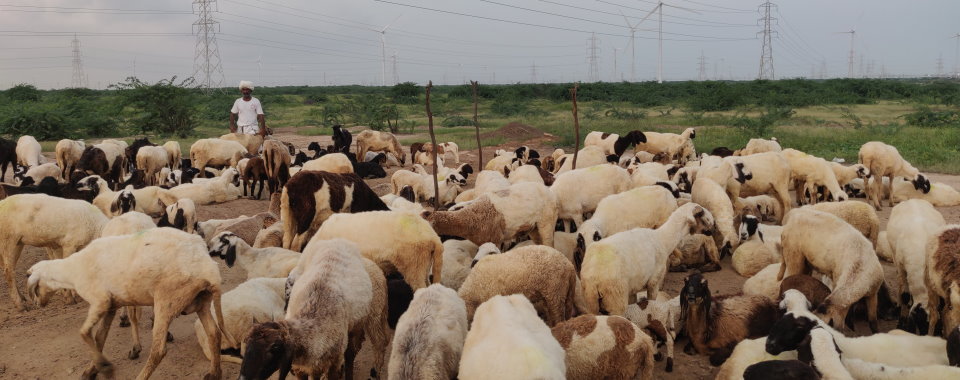Last month’s UN Food Systems Summit was highly controversial. Back in July, around the pre-summit process, small-scale farmers and their allies raised concerns that the agenda was being set by corporations, investors and other powerful actors. On the day of the Summit itself, the alarm was raised again. The UN Special Rapporteur on the Right to Food, food researchers, producers and activists accused the UN of failing to listen to small food producers. The Summit, they warned, left little room for small-scale food producers in shaping the future.
As shown in a new report co-published by the Pastoralism, Uncertainty and Resilience (PASTRES) programme, Are livestock always bad for the planet?, among those ignored in global debates are millions of small-scale livestock-keepers worldwide, practising relatively low-impact, extensive pastoralism in drylands, mountains and other marginal environments. The report was discussed in an online event last week with Ian Scoones, the report’s co-author, alongside a panel of expert commentators.
Simplified debates, problematic solutions
The pressure on pastoralists has intensified as climate change bites and global leaders talk of critical turning points for action. Debates about climate, meat and milk on social media and in the press are hyper-simplified. In public battles around food and the climate, livestock have often been painted as a ‘villain’ of climate change.
Genuine concerns about the problems of industrial production and overconsumption of meat, mainly among a ‘consumption elite’ in the rich world, can easily translate into more generalised prescriptions for radical changes in diet to save the planet. Without a doubt, the global impacts of livestock are significant, made worse by interests that value profits above all. Behind the global figures, there is a great deal of diversity. Despite this, herds of cattle, reindeer, yaks, camels, sheep and goats, and their keepers, are largely absent from dominant Western low-carbon visions of the future.
The alternatives to livestock production are gathering steam too: celebrity-backed ‘cultivated meat’, high-tech plant based food, the ‘techno-vegetal solutionism’ of aspirations to plant a trillion trees, rewilding, forestry and conservation schemes – some of them smaller-scale and more sensitive, some imagined on a more massive scale, like the billion-dollar investments just announced by Amazon CEO Jeff Bezos.
What this means for pastoralists will depend on how and where such schemes might be implemented, but their voices are unlikely to be heard in the boardrooms and multinational assemblies that aim to reshape the global food system.
Climate and livestock: examining the evidence
The debates don’t stop at the UN Food Systems Summit. Methane emissions of food systems will be on the agenda at the COP26 climate conference in November too. This makes it an urgent task now to examine livestock’s role in climate change, and examine the evidence that global decision-makers might use to inform their actions. The PASTRES report looks at the simplified models that link livestock and climate change, and finds a host of gaps and problems:
- Global assessments are overwhelmingly based on data from industrial systems in rich countries. But where and how meat is produced can make a huge difference.
- Data from some regions are under-represented in global studies – like Africa, where extensive pastoralism is common across large areas.
- The benefits that pastoralism can have for carbon sequestration and the wider ecological system are not always taken into account. Their knowledge and experience is also vital for improving the way that rangelands are managed.
- Cows and cars not the same, as methane and carbon dioxide have different lifetimes in the atmosphere, but popular narratives about climate change treat them as equivalent.
- In significant areas of the globe, people rely on animal-source food for nutrition, especially for young children, where alternatives aren’t available.
Given these problems, there’s an urgent need to widen the debate about how to create a more climate-friendly food system. So how can pastoralists’ views and insights be made more central in the conversation?
Making pastoralists central to the debate
Firstly, food systems debates should widen the focus to the production process, not just the product. This also means adopting a systems approach and recognising the diversity in ecosystems where livestock herding happens. Life Cycle Analyses, a mainstay of assessments of climate impacts, can be very useful, but they need to recognise that ecosystems and landscapes are highly variable.
Secondly, more research is needed on carbon and nitrogen flows, context-specific emissions and carbon sequestration in extensive livestock systems, including in pastoral areas across the world, to inform appropriate action.
Thirdly, transforming the food system means looking at the economic pressures that push consumers on limited budgets towards cheap meat and milk, and make it hard for more sustainable livestock-keepers to compete or get access to markets. The biggest and most urgent changes in diets are needed among those in industrialised countries who over-consume meat and milk. But access to good nutrition is centrally about also about more equitable access to good food for poorer people, reforming the systems that limit choice.
Finally, pastoralists themselves have valuable insights and knowledge to share – for example, on developing better systems for feeding and managing manure that cut down on methane, and using mobile grazing to sequester carbon in the ground. Rather than being continually excluded from debates, as the report argues, pastoralists need to be central to debates about the future of food and the climate, showing the way forward through demonstrating the value of low-impact, extensive systems.
Find out more
Download the report Are livestock always bad for the planet? by PASTRES and 13 other organisations, together with briefings and information sheets in multiple languages (details on the publication page).
